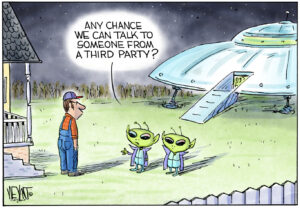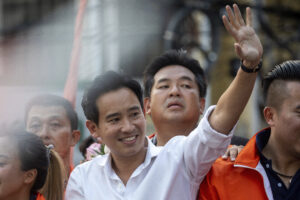The Real Voter Fraud
By repeatedly attacking the integrity of elections, Republicans have managed to disenfranchise the voters whose votes they're unlikely to get.WASHINGTON — The fiasco over the fired U.S. attorneys started out as a footnote.
“The president recalls hearing complaints about election fraud not being vigorously prosecuted” and “may have” mentioned this to Attorney General Alberto Gonzales, White House spokeswoman Dana Perino admitted — after it became impossible to deny that crass politics, not job performance, was at the root of the imbroglio over dismissed federal prosecutors.
The operative phrase is “election fraud,” though in Republican parlance it is usually called “voter fraud.” Republicans claim, loudly and regularly, that an army of ineligible voters — illegal immigrants, convicted felons, dead people — has been invading American polling places, diminishing the value of honest voters’ sacred ballots. They make the charge in states where the administration of elections is highly competent, and in states where it is grossly incompetent. It is, of course, leveled solely against Democrats and their supporters.
The charges are almost invariably debunked — by courts, by prosecutors, by state elections officials and by local newspapers that probe beyond partisan screeching and get down to the facts.
“There is widespread but not unanimous agreement that there is little polling place fraud, or at least much less than is claimed, including voter impersonation, ‘dead’ voters, noncitizen voting and felon voters,” says a May 2006 report to the U.S. Election Assistance Commission. The bipartisan commission didn’t widely release the consultants’ review, but makes it available on request. It issued a follow-up in December saying there was “no consensus” about fraud and intimidation at the polls and the entire matter deserves — what else? — more study.
Besides rejecting the notion that hordes of ineligible voters are stealing elections, the consultants’ study refutes another common Republican claim — that false registration forms are leading to rampant fraud. The study even cites Craig Donsanto, chief of the Justice Department’s election crimes branch, as saying “the number of election fraud related complaints has not gone up since 2002.” He also says the “proportion of legitimate to illegitimate claims of fraud” is unchanged.
The Justice Department’s own statistics show that of 87 ballot-fraud convictions obtained since the department launched its “voter integrity” initiative in 2002, 17 were for noncitizen voting and another six were for multiple voting. Most of the cases involved vote-buying schemes hatched by local politicians in Kentucky, West Virginia and elsewhere.
So, with 122 million votes cast in the 2004 elections, and about 83 million cast last November, what are the statistical chances that some votes are fraudulent? You do the math.
And what about all the sensational claims? They are sensational claims.
Take the 2004 Washington state gubernatorial election, which appears to figure in the dismissal of former U.S. Attorney John McKay. When the skintight race flipped to Democrat Christine Gregoire after a recount, Republicans cried foul. But after six months of legal investigation and a two-week trial, a county court judge rejected every Republican claim. Though he said there were improper votes cast, the judge also declared he’d found no evidence of fraud. The Republicans didn’t appeal.
In Ohio, some Republicans after the 2004 presidential election circulated stories of dead voters and those who showed up to vote several times — they even conjured up the image of voters who supposedly were bused in from West Virginia during the 1960 election. But a study by the state’s League of Women Voters and a group representing the homeless found that of the 9 million votes cast in Ohio in 2002 and 2004, a total of four were deemed ineligible or fraudulent by the Board of Elections or local prosecutors. “The odds are greater to win the lottery or get struck by lightning than someone casting an ineligible vote in Ohio,” the report concluded.
In Connecticut, state officials became alarmed when the Republican National Committee claimed that 54 residents had voted twice — in Connecticut as well as in another state — in the 2000 election. But a probe by the secretary of state discovered that most hadn’t voted in Connecticut at all, while some had voted in Connecticut but not in the other state. Four had birth dates different from those supplied by the RNC. In New Jersey, Missouri, Michigan and elsewhere, hot claims of fraud have likewise turned out to be hot air, according to an examination of the cases by Barnard College scholar Lorraine C. Minnite.
But the vote-fraud folklore serves its purpose. It enables Republicans to push through state requirements for photos and other forms of voter identification, rules that depress turnout and impact elderly and minority voters — that is, Democrats — most seriously. This is the real fraud.
Marie Cocco’s e-mail address is [email protected].
© 2007, Washington Post Writers Group
Your support matters…Independent journalism is under threat and overshadowed by heavily funded mainstream media.
You can help level the playing field. Become a member.
Your tax-deductible contribution keeps us digging beneath the headlines to give you thought-provoking, investigative reporting and analysis that unearths what's really happening- without compromise.
Give today to support our courageous, independent journalists.






You need to be a supporter to comment.
There are currently no responses to this article.
Be the first to respond.